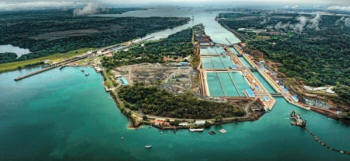|
Panama opened the long-delayed $5.4 billion
expansion of its shipping canal amid cheering crowds on Sunday, despite looming
economic uncertainty in the shipping industry and a heated battle over billions
in cost overruns. (Image courtesy Panama Canal Authority)
 At
7.50 a.m. (1250 GMT), the Chinese container ship "Cosco Shipping Panama" entered
the Agua Clara lock on the Atlantic to begin the first crossing of the roughly
50-mile-long (80.45-km-long) waterway and was due to emerge on the Pacific side
by 5.00 p.m. (2200 GMT). At
7.50 a.m. (1250 GMT), the Chinese container ship "Cosco Shipping Panama" entered
the Agua Clara lock on the Atlantic to begin the first crossing of the roughly
50-mile-long (80.45-km-long) waterway and was due to emerge on the Pacific side
by 5.00 p.m. (2200 GMT).
The expansion, which triples the size of ships
that can travel the canal, allows the country to host 98 percent of the world's
shipping and is aimed at wresting market share from rival Suez and U.S. land
routes made cheaper by low oil prices.
By 2021, the Panama Canal Authority (ACP) is hoping the project will bring in
$2.1 billion per year in added revenue, representing 2.8 percent of gross
domestic product.
"As a Panamanian, I am proud," said Odalis Castillo, an 18-year-old student who
attended the launch. "There will be more money to spend on social projects."
But the ACP is enmeshed in a $3.587-billion conflict over cost overruns with
Spain's Sacyr and Italy's Salini Impreglio [IPGIN.UL], which won the project in
2009 and finished it two years late, amid construction setbacks and strikes.
It also faces challenges like the supply of fresh water needed to move the giant
locks and safe handling of the huge ships.
So far 170 ships have signed up to use the canal in the next three months. If
the industry perks up, the ACP already has a $17 billion plan for a fourth set
of locks to lure even bigger ships that can now only travel through the Suez
Canal.
Just a dozen of the 70 heads of state invited to see the debut of the third set
of locks attended the ceremony but Panama's Foreign Ministry hailed the event a
diplomatic success, with representatives from nearly all the invited countries
in attendance.
Analysts said the rank of those leading the delegations was affected by the
Panama Papers scandal, in which millions of documents were leaked from law firm
Mossack Fonseca, revealing how some of the world's richest people use offshore
companies to avoid tax and launder money.
Jill Biden, the wife of U.S. Vice-President Joe Biden, led the delegation from
the United States, which finished building the canal in 1914, controlled it
until 1999 and is still its biggest user. |


